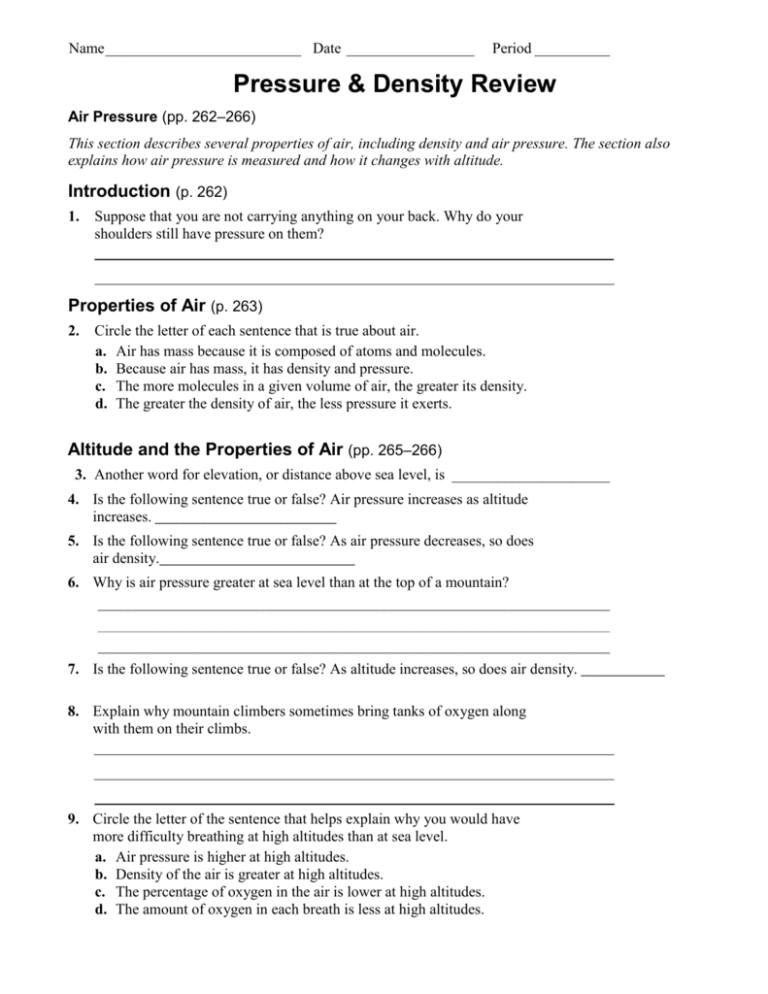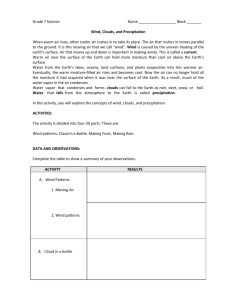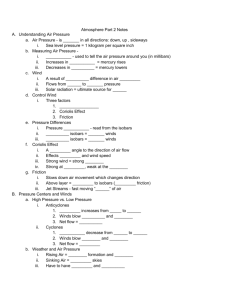Pressure & Density Review
advertisement

Name __________________________ Date _________________ Period __________ Pressure & Density Review Air Pressure (pp. 262–266) This section describes several properties of air, including density and air pressure. The section also explains how air pressure is measured and how it changes with altitude. Introduction (p. 262) 1. Suppose that you are not carrying anything on your back. Why do your shoulders still have pressure on them? Properties of Air (p. 263) 2. Circle the letter of each sentence that is true about air. a. Air has mass because it is composed of atoms and molecules. b. Because air has mass, it has density and pressure. c. The more molecules in a given volume of air, the greater its density. d. The greater the density of air, the less pressure it exerts. Altitude and the Properties of Air (pp. 265–266) 3. Another word for elevation, or distance above sea level, is _____________________ 4. Is the following sentence true or false? Air pressure increases as altitude increases. __________________________ 5. Is the following sentence true or false? As air pressure decreases, so does air density.____________________________ 6. Why is air pressure greater at sea level than at the top of a mountain? ____________________________________________________________________ ____________________________________________________________________ ____________________________________________________________________ 7. Is the following sentence true or false? As altitude increases, so does air density. ____________ 8. Explain why mountain climbers sometimes bring tanks of oxygen along with them on their climbs. 9. Circle the letter of the sentence that helps explain why you would have more difficulty breathing at high altitudes than at sea level. a. Air pressure is higher at high altitudes. b. Density of the air is greater at high altitudes. c. The percentage of oxygen in the air is lower at high altitudes. d. The amount of oxygen in each breath is less at high altitudes. Name __________________________ Date _________________ Period __________ Wind Review Winds (pp. 282–288) This section explains what causes winds and how winds are measured. The section also describes different types of winds that blow across Earth’s surface. What Is Wind? (p. 283) 1. The horizontal movement of air from an area of high pressure to an area of lower pressure is referred to as 2. Is the following sentence true or false? Winds are caused by differences in air pressure. Match the instrument with what it measures. Instrument What It Measures _______ 3. wind vane a. wind speed _______ 4. anemometer b. wind direct 5. Is the following sentence true or false? A south wind blows toward the south. 6. The increased cooling that a wind can cause is called the 7. Why does the wind blowing over your skin make you feel colder? Local Winds (p. 284) 8. Winds that blow over short distances are called 9. What causes local winds? 10. Circle the letter of each sentence that is true about the unequal heating of land and water. a. Land warms up faster than water. b. During the day, air over water is warmer than air over land. c. Water cools more quickly than land. d. At night, air over water is cooler than air over land. 11. Use the picture below to answer the following questions Location A Location B N W E S __________ a. Which location represents a higher-pressure location? __________ b. Which location is denser? __________ c. Which location represents warmer air? __________ d. What direction is the wind blowing? A. North B. South C. East __________ e. What do you call this wind? A. North Wind B. South Wind C. East Wind D. West D. West Wind 12. Draw a land breeze and label pressure, density and wind direction. Global Winds (p. 285) 13. Winds that blow steadily from specific directions over long distances are called 14. Circle the letter of each sentence that is true about global winds. a. They are created by unequal heating of Earth’s surface. b. They are produced by the movement of air between the equator and the poles. c. They blow in a straight line from the poles toward the equator. d. They curve because of Earth’s rotation 15. As Earth rotates, the Coriolis Effect causes winds in the Northern Hemisphere to turn toward the







